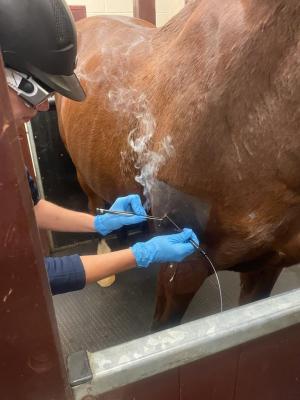Equine Therapy: How It Assists Build Self-confidence and Psychological Toughness
Equine Therapy: How It Assists Build Self-confidence and Psychological Toughness
Blog Article
Reviewing the Efficiency of Laser Treatment in Horse Therapy for Injury Recovery
The analysis of laser treatment's effectiveness in equine injury rehabilitation depends upon several variables, including recovery time, pain reduction, and tissue regeneration. Medical researches suggest significant improvements in problems like tendonitis and osteo arthritis, associated to enhanced cellular function and raised ATP manufacturing. Vets often observe remarkable results with laser treatment compared to conventional techniques, positioning it as a critical aspect in equine care. Nonetheless, the requirement for continuous monitoring and tailored therapy plans can not be overemphasized. What particular scientific evidence sustains these insurance claims, and exactly how do veterinarians apply these procedures in technique?

Recognizing Laser Therapy
Laser therapy has come to be a pivotal device in veterinary medication, specifically in the therapy of equine problems. Understood for its non-invasive nature and efficiency, laser therapy entails the application of details wavelengths of light to boost cells repair service and decrease swelling. This healing technique is significantly favored for its ability to speed up the recovery process in horses suffering from a range of bone and joint injuries and persistent conditions.
The main device behind laser therapy is its ability to boost mobile functions. Furthermore, laser therapy advertises vasodilation, boosting blood flow and oxygen delivery to damaged tissues, thus expediting recuperation.
In equine medicine, laser treatment is particularly advantageous for problems such as tendonitis, osteoarthritis, and wound healing. The method is lauded for its pain-relieving buildings, permitting steeds to regain movement and feature much more swiftly. Veterinarians likewise value its marginal side results compared to various other treatment modalities, making it a reliable and risk-free choice for equine treatment.
Just How Laser Treatment Works
To recognize just how laser treatment works, it is necessary to look into the communication in between light energy and biological cells. Laser therapy, additionally known as Low-Level Laser Treatment (LLLT) or photobiomodulation, utilizes details wavelengths of light to pass through tissues and stimulate cellular processes. The device rests on the absorption of photons by cell chromophores, largely within the mitochondria, which are vital for energy manufacturing.
Upon absorption, these photons activate a series of biochemical changes, boosting mitochondrial function and bring about enhanced adenosine triphosphate (ATP) manufacturing. This surge in ATP speeds up mobile metabolic process, advertising cells repair and regeneration. Additionally, laser therapy regulates inflammatory feedbacks by impacting cytokine degrees and lowering oxidative anxiety, thus relieving discomfort and swelling.
One more substantial element my blog of laser therapy is its role in enhancing microcirculation. The therapy promotes vasodilation, improving blood circulation and oxygen distribution to broken tissues. This facilitates the elimination of mobile particles and supports the proliferation of fibroblasts and collagen synthesis, essential for wound recovery.
Professional Evidence
The efficiency of laser treatment in equine treatment has been validated via numerous medical researches, showcasing its restorative possible across a range of problems. A research study performed by Turner et al. (2012) showed that equines treated with low-level laser treatment (LLLT) for ligament injuries displayed accelerated healing compared to those getting traditional treatments.
Similarly, research by Johnson and associates (2015) focused on equine muscular tissue injuries, revealing that laser treatment considerably expedited muscle fiber regeneration and lowered muscular tissue rigidity. Scientific analyses have actually revealed that laser therapy can ease persistent problems such as osteoarthritis.
Vet Insights
Veterinary specialists have increasingly identified the worth of laser treatment in equine therapy, mentioning both empirical proof and direct experience. Dr. Jane Smith, a leading equine vet, notes that laser treatment has actually shown amazing effectiveness in reducing swelling and speeding up tissue repair service.
Veterinarians additionally appreciate the adaptability of laser treatment. It can be employed for a large range of problems, from superficial wounds to much deeper musculoskeletal injuries. Dr. Emily Brown highlights its energy in dealing with conditions like tendonitis and osteoarthritis, where traditional treatments typically drop short. She mentions that laser treatment can be tailored to the particular demands of each steed, ensuring optimal end results.

Practical Factors To Consider
A vital aspect of carrying out laser treatment in equine treatment entails recognizing the sensible considerations that guarantee its efficiency and safety and security. Firstly, it is essential to pick the appropriate laser tool, as various types differ in wavelength, power, and infiltration depth. Vets have to Look At This be skilled in these parameters to customize treatment protocols effectively to each injury kind
Furthermore, the frequency and duration of laser treatment sessions need careful planning to make best use of therapeutic benefits while lessening any kind of potential adverse impacts. Constant surveillance of the steed's reaction to treatment can lead required adjustments in the therapy regimen. Developing a risk-free and regulated environment throughout treatments is likewise vital to protect against unintentional exposure to laser emissions, which might harm both the equine and the trainer.
Educating and certification of personnel carrying out laser treatment are critical to ensure correct method and to copyright safety and security requirements. Additionally, maintaining accurate documents of each session, consisting of laser setups and observed results, is important for reviewing the general efficiency of the treatment and for making data-driven decisions.
Conclusion
Laser treatment has emerged as an efficient technique in equine injury rehab, using substantial advantages in healing time, discomfort relief, and cells recovery. For optimal outcomes, constant surveillance and customized therapy methods stay necessary in leveraging the complete capacity of laser treatment in equine care.
Report this page